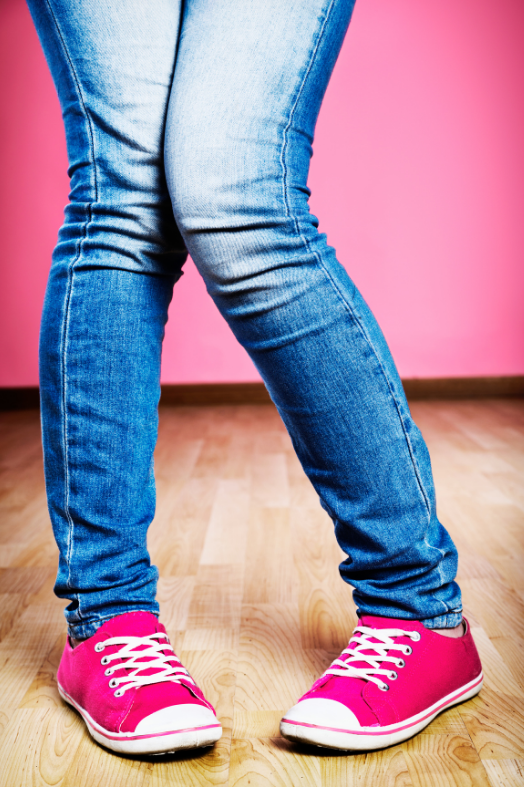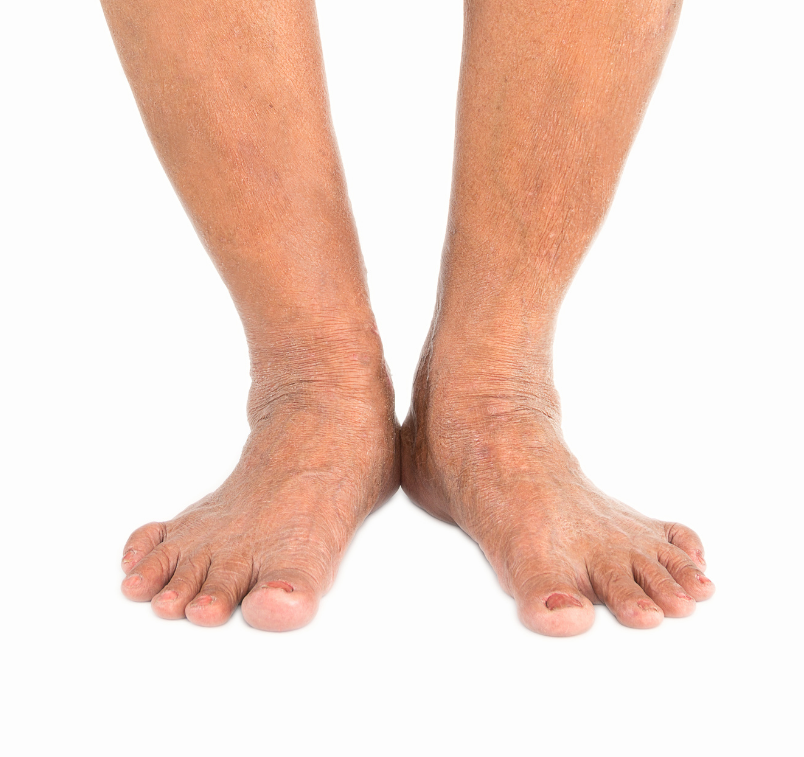As kids grow and learn to walk and run, their bodies go through so many changes. Their bones are growing bigger and stronger, their coordination and balance are developing, their muscles are getting bigger, stronger and more flexible, and as a result, the position of their feet and legs go through a number of changes.
Two of these changes are in-toeing and out-toeing. While both positions can be a normal and healthy stage when kids are first learning to walk confidently, when they persist past a certain age or continue for too long, they may cause painful problems or make kids more vulnerable to injury.
In-Toeing

In-toeing is often referred to as pigeon-toeing and describes the position where children are walking with their feet turned inwards to face one another. This inwards rotation may be mild or very pronounced, and may affect one or both feet. Generally speaking, the ‘normal’ period of in-toeing can range from the first steps up to four years of age. When your child continues to in-toe past this age or with great severity, this may be caused by:
- Inwards rotation of the shin bone (tibia) – if your shins are twisting inwards, then the foot will also twist to face inwards, even if the position of the foot relative to the lower leg is relatively straight. This is likely related to your child’s position in the womb, though it doesn’t become noticeable until they start walking.
- Metatarsus adductus – the simplest way to describe this is that the front half of the foot is twisting inwards on the back half of the foot, resulting in a bean or banana shape. You’ll likely notice it at birth, and approximately 1 in 1000 births are affected.
- Inwards rotation of the thigh bone (femur) – similar to the inwards rotation of the shins, but the inwards rotation of the thigh bone, which means that the knee, lower leg and foot face inwards too. You may be able to spot this one because the knee turns inwards too.
Out-Toeing

Out-toeing, on the other hand, is referred to as being duck-footed and describes the position where the feet are twisted outwards away from one another instead of pointing straight ahead. Again, the severity can vary and may affect one or both feet. Much like in-toeing, out-toeing should also resolve by the age of four or five, and may be a result of:
- Outwards rotation of the shin bone (tibia) – when the shin bone is rotated outwards, the foot is rotated outwards too
- Outwards rotation of the thigh bone (femur) – this is when the thigh bone is twisted outwards, which positions the knee, shin bone and foot outwards too
- Outwards rotation of the hip – this is usually associated with some tight and contracted muscles, and is likely associated with the position in the womb
- Flat feet – this creates more of an appearance of out-toeing than actual out-toeing itself. As the feet roll in and the toes point outwards, the feet have an appearance of out-toeing
Treating In-Toeing & Out-Toeing
Managing both conditions is important because without treatment, kids are more likely to trip and fall during sports, it may have an impact on their muscles and ligaments, and the body may start to make other compensations or over work, which will put them at a higher risk of pains and aches.
We treat both in-toeing and out-toeing safely and effectively without surgery or painful or invasive treatment. We have proven processes that deliver the best results for our patients, which involves a special type of orthotic to help rotate the feet and legs appropriately, stretching and strengthening exercises, and wearing good, stabilising shoes.
FAQs
Are there any complications associated with in-toeing?
In most cases, in-toeing does not lead to significant complications. However, some individuals with severe in-toeing may experience foot pain, gait abnormalities, or difficulty with certain activities. It’s important to monitor the condition and seek treatment if these complications arise.
Are there any exercises or stretches that can help with in-toeing?
Certain exercises and stretches may help improve the muscle strength and flexibility, which can contribute to better alignment of the feet. These exercises may include toe walking, heel walking, hip rotations, and stretching the calf muscles. It’s always best to consult with your podiatrist to determine the appropriate exercises for your specific case.
Can in-toeing affect my child’s ability to walk or participate in physical activities?
In most cases, in-toeing does not significantly impair a child’s ability to walk or participate in physical activities. However, severe in-toeing or associated complications may affect gait patterns and impact certain activities. If you notice any concerns with your child’s mobility or discomfort during physical activities, we highly recommend bringing your child in for an assessment.
How long does it take to resolve in-toeing with treatment?
The duration of treatment for in-toeing can vary depending on the underlying cause and the specific treatment approach. Exercises, stretches, orthotics and the treatment options we’ve mentioned will contribute to improvement over time.
Can in-toeing be hereditary?
Yes, in-toeing can have a hereditary component. Some forms of in-toeing, such as metatarsus adductus or familial internal tibial torsion, have been linked to genetic factors. If you or your partner had a history of in-toeing, it may increase the likelihood of your child experiencing it as well. Not all cases of in-toeing are hereditary, however, and other factors such as fetal positioning in the womb can also contribute to the condition.
How often should my child be monitored for in-toeing?
The frequency of monitoring for in-toeing depends on the severity and underlying cause of the condition. We recommend having an initial assessment with our team, and at this appointment we’ll address all of your concerns including the frequency of follow-ups and monitoring, or treatment reviews as needed.
Are there any complications associated with out-toeing?
Out-toeing typically does not lead to significant complications on its own. However, it may result in gait abnormalities, tripping, or challenges with certain physical activities. Additionally, underlying conditions causing out-toeing, such as hip dysplasia or neuromuscular disorders, may have associated complications that require attention.
Are there any exercises or stretches that can help with out-toeing?
Exercises and stretches focused on improving muscle strength and flexibility can be beneficial for individuals with out-toeing. These may include hip stretches, leg stretches, and exercises targeting the hip abductor muscles. Your podiatrist will discuss these with you at your initial assessment.
Are there any long-term effects of out-toeing if left untreated?
If left untreated, out-toeing itself typically does not have significant long-term effects. However, it’s important to identify and address the underlying cause of the out-toeing, as certain conditions or muscle imbalances may have associated long-term effects or complications.
Can out-toeing be hereditary?
Similar to in-toeing, out-toeing can have a hereditary component. Certain conditions associated with out-toeing, such as femoral anteversion, may have a genetic predisposition. If you or your partner had a history of out-toeing or related conditions, there may be an increased likelihood of your child experiencing it as well. However, not all cases of out-toeing are hereditary, and other factors can also contribute to the condition.
